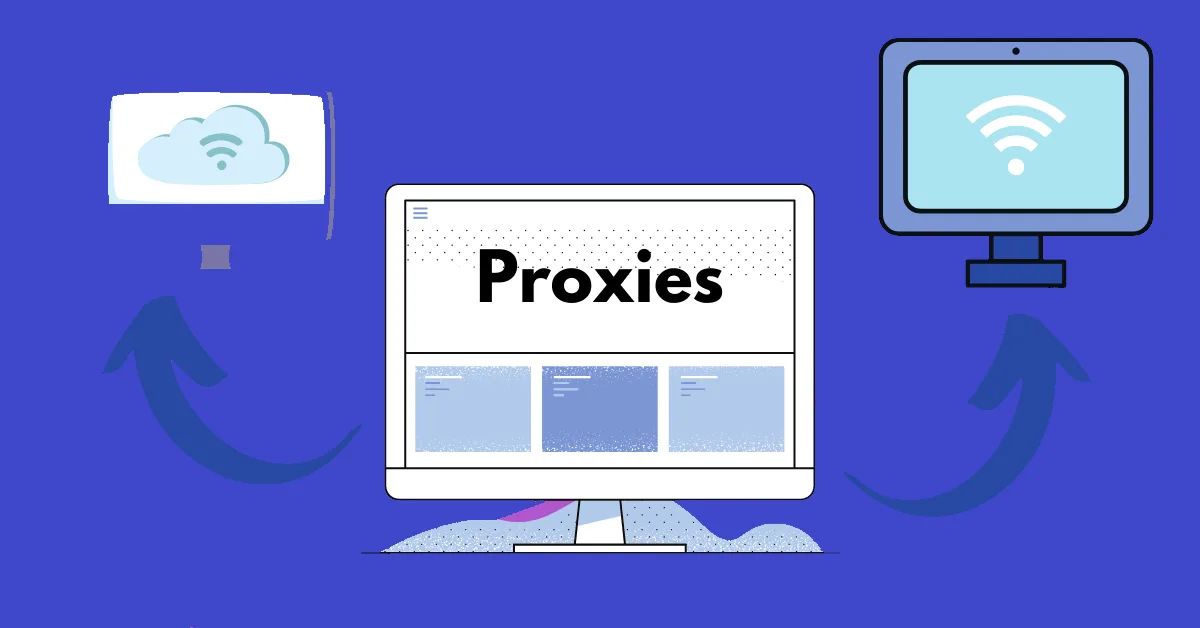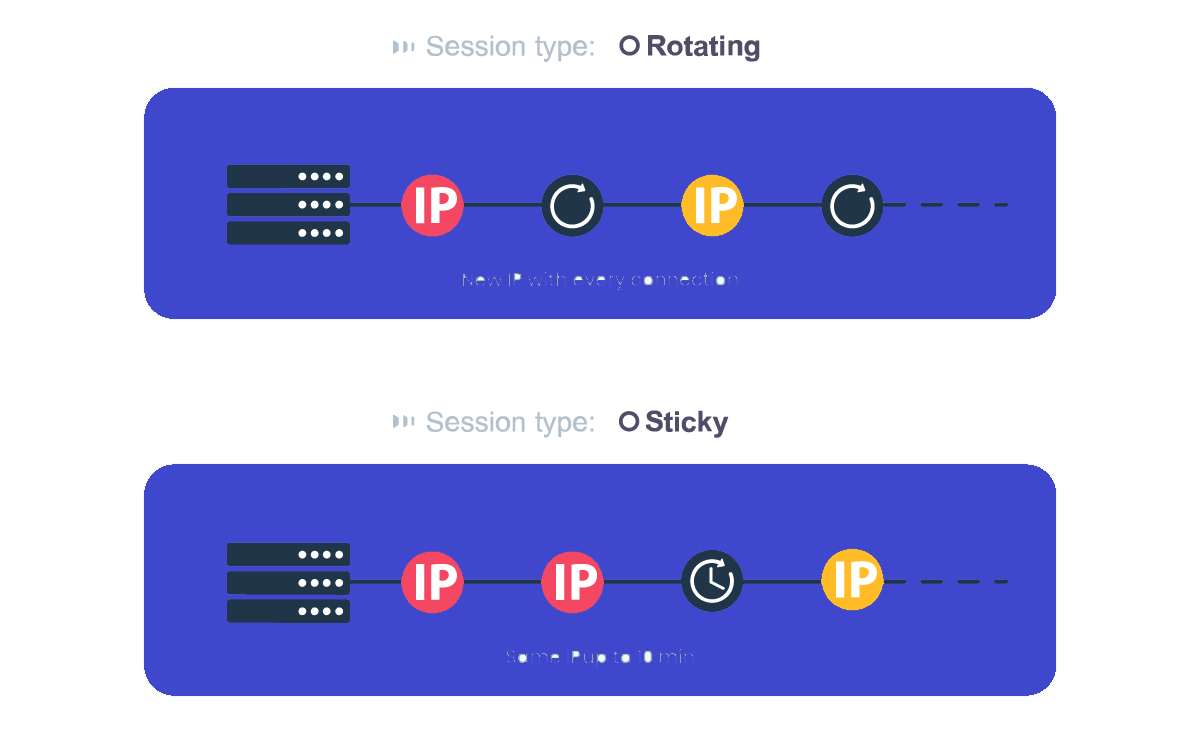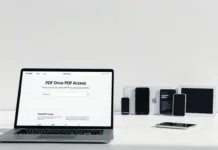Proxy types? Whether you are new or experienced in the automation business, you must be sometimes confused with the terms used by proxy providers. Well, you should be.
Proxy providers will often use vague terms in misleading ways to attract new customers, some of these terms don’t actually hold any real meaning at all and are just marketing terms, while some of them are indeed real.
Some of these terms are also used interchangeably with one other but actually mean the same thing.
So what are the proxy types? Some of these terms are “Residential”, “Rotating”, “Private”, “Shared”, “Elite”, “Social Media Proxies” and many more. But, what do they really mean?
In today’s blog, we are going to find out the proxy types and their meanings.
PROXY TYPES
Private & Shared Proxy Types
A private proxy is a proxy that only one person (you) have access to, it is not shared with anyone else. You should always use private proxies exclusively if you care about your accounts not getting banned.
Some use the term private to indicate that the proxy is not public (can be accessed by anyone for free) – this is misleading and you should always check what exactly the provider is offering before doing business with him.
A shared proxy is a proxy that is shared between two or more people and is considered being significantly lower quality than a private proxy, using a shared proxy means that you are sharing your IP with some else, a complete stranger (most likely strangers), that is running an unknown amount of users on it and is very likely to get the IP blacklisted by big tech companies.
Do not use shared proxies if you care about your accounts not getting banned, they are not designed for account growth but for other purposes.
Elite Proxy
A misleading, meaningless marketing term, It is basically the same as saying “the best proxy” or “a great proxy”.
This term somehow became very popular in the proxy market and suppliers use it to make customers think they are getting a superior product when actually they do not.
Suppliers know that customers in the proxy market think that “Elite” has some kind of meaning that they do not understand that makes the proxies somehow better than others, they will even sometimes sell these at a premium.
If a provider markets their proxy as “Elite” you should know that this is 100% marketing and you should be careful about doing business with them, as they clearly don’t mind misleading their customers.
Rotating/Dynamic Proxy
A rotating proxy is a proxy that has rotating IP addresses, it means that the proxy server will change its (and yours) IP every a defined amount of time or requests (or just naturally every now and then).
Rotating proxies are good if you are scraping, want to look more like a natural user, or are creating accounts.
These proxies are also called dynamic proxies and they look more natural and are considered of higher quality since real users have their IPs changed once in a while, for example, when they restart their home router.
For this reason, a residential proxy must be a rotating proxy, since real users have their IPs naturally rotated once in a while.
Mobile proxies will always have rotating IPs, if your mobile proxy is not changing IP once in a while, it is definitely not a mobile proxy.
These IPs are what’s called “back connect,” since you are not connecting to their public IP (you can’t because it keeps changing and you will have to update your proxy IP every time it changes), but instead, you are connecting to the network from a different static IP and then your IP gets changed (forwarded) to the rotating IP, all mobile & rotating proxies are back connected proxies.
When buying a rotating IP make sure the IPs don’t all belong to the same subnet, as it would make them all blacklisted very easy and the whole thing pointless and also make sure it is of a decent IP pool size.
You don’t have to worry about these 2 points if the proxy is mobile, it will always have a big IP pool and the subnet can’t be blacklisted (they will have to blacklist the whole carrier).
Static Proxy
Compared to a rotating proxy, a static proxy is a proxy that has IP never changes, this necessarily means that the proxy is a data center proxy, since static IPs are only allocated to companies or users that pay extra money to specifically request a static IP from their ISP.
Since static IPs are not back connected, you connect to them using their public IP, so if you buy a proxy and get log-in details such as example_user:example_pass@example_IP:example_port and an IP check return example_IP as your public IP, your proxy is definitely static.
To make sure your proxy is not static just check your public IP every once in a while and make sure it changes.
Residential Proxy
Residential proxies are the most abused and misleading term used by proxy providers and most often than not what’s being sold is not a true residential proxy.
The issue is that different providers define “Residential” in different ways and there isn’t an official definition, this makes scamming people very easy.
In this part, I will explain what a residential proxy is and the different levels of quality it has and you can use that information yourself to decide how you define a residential proxy.
The way I define a residential proxy is a way the big technology companies define a residential IP – an IP that was allocated for residential use and is actively producing organic traffic by real users.
However, things get way more complicated than that.
Sure, basically any company can contact an ISP that owns residential IPs and ask to buy these IPs, and most times ISP will agree to sell these, but then a few issues come up to mind.
The first is that ISPs will only sell these IPs in blocks (subnets) and the providers will only be able to provide IPs from the same (or a few) subnets, making these IPs very easy to detect and blacklist.
The second is that once these IPs move to the ownership of the proxy providers they will no longer produce real organic residential-like user traffic and big tech is always monitoring IP traffic to make sure it’s genuine, so, if the flow of real organic traffic coming from these IPs will stop, big tech will figure out these IPs are not real residential IPs really fast.
Basically, everything you do on the web is monitored and is correlated to your IP by big technology companies.
If a certain IP subnet is supposedly allocated to a neighborhood in California, Google and Facebook will expect it to have at least a few hundred devices connected at a time and produce genuine traffic (they are extremely good at determining what is genuine traffic) and if the subnet doesn’t, they will quickly blacklist the subnet.
The last issue is that ISPs outright sell ownership data of IPs to big tech (mostly Facebook and Google) letting them know who really owns these IP addresses at the end of the day.
Many providers who purchase static residential allocated IPs from ISPs will often create a proxy server that rotates them and call it a residential proxy, however, is it really a true residential proxy? I think it isn’t and after reading this I hope you think so too, these IPs will get blacklisted and marked as a data center in a split second.
Creating and selling a true residential proxy will require much more work, like getting IPs from many different subnets, making sure they were allocated for residential use, making sure that the ISP isn’t selling the ownership data to big tech, and that they produce real traffic 24/7.
Now you must be thinking, this all sounds really complicated and expensive, how can a proxy provider sell real residential proxies? Well, they can’t, at least in the usual way.
The only way to sell 100% real residential proxies is to gain access to people devices, legally or illegally, and make use of their internet connection to produce a proxy server, most of the time with the user unaware, this can be done via an app in the App/Play store, a software or even malware.
Remember, this is illegal in most cases and can even potentially get you in trouble if the IP address can eventually trace back to you. Also, when using these proxies you will use an internet connection of someone who most likely already has his own accounts, so you are basically using a shard proxy and that can put your accounts at risk.
4G/LTE/Mobile Proxy Types
4G proxies, often called LTE/Mobile proxies are proxies that are created by using real SIM cards.
These proxies are the holy grail of proxies and I will explain why.
Remember what I explained in my previous article Origin of IPs and how are they assigned?
If you haven’t read this blog, the short story is that there are two types of IP protocols – IPv4 and IPv6, since IPv4 ran out of address IPv6 was introduced, however, since these are not compatible with each other IPv4 still is the only real used IP protocol and is a major shortage all around the world.
This led ISPs to use a technology called NAT (Network Address Translation), which basically means that a number of users can use the same IP address at a time, this happens mostly with mobile ISPs and not home ISPs and is great news for growing accounts.
Multiple people sharing the same IP address (up to thousands of people at once) means that the IP can never be blacklisted, imagine Instagram trying to ban your 4G IP – they will have to ban 10s-100s other legitimate users as well.
Furthermore, since 4G proxies are using NAT they are back connected and have a huge pull of unbannable IPs that you can rotate between in seconds just by logging in and out of the network, each time getting an unbannable different IP from your carrier.
This basically makes 4G proxies the ultimate proxies, as they can never ever be blacklisted, can be rotated indefinitely and since you share your IP with tens of thousands of people, they also produce massive amounts of real user traffic.
These are the best and only proxies you should use if you really care about your accounts.
To find out how to identify real 4G proxies and avoid scams read my guide – How to know if a proxy is really 4G.
Virgin Proxies
Virgin IPs are IPs that are completely new and which the internet has never seen before, in today’s world – they are a myth and they do not exist anymore.
The last IPv4 in the world was assigned in the 25th of November 2019 by RIPE and since then we officially ran out of new IPv4 address, it is possible though that some IPs have been assigned in the past but has never been used to this day, but they are extremely rare and it is hard to tell if an IP is brand new or not.
Virgin IPs in today’s world mean IPs that are “virgin” to your specific task, for example, a “virgin Instagram IP” is an IP that Instagram has never ever seen before and can find no data on anywhere on the web, these are also very rare and there is no real way of telling if an IP is a virgin IP or not, since there can always be some record of it somewhere on the web and Instagram’s databases are not publicly accessible.
While you can try very hard to find some info on a specific IP using WHOIS checks, history logs, and geolocation data directories and find nothing – it is still very possible and likely that someone, somewhere does have some historic data on the IP, thus making it a nonvirgin IP.
Some proxy provider will this term for marketing, I advise you to stay away from there providers as they clearly don’t mind misleading their customers, these IPs no longer exists and even if you do manage to find one somehow, chances are it was allocated to a business and is a data center IP.
I’d argue that 4G IPs would be better than virgin IPs anyway, since having good historical data on an IP is better than having no data at all.
Social Media/Instagram/Ticketing/Facebook Proxy Types
Generally speaking, these terms don’t hold any real general meaning, they are simply marketing terms that sometimes mean something and sometimes don’t mean anything – they have no official or generally accepted meaning.
While they have no general meaning, they sometimes mean that the provider is doing something to the proxy server to optimize it for a specific task, for example, block all other traffic but Facebook/Instagram or rotate the IP each time it is detected automatically (this is good for scraping).
A lot of proxy suppliers use these terms for marketing whether they mean anything or not, however, I would not consider these terms misleading or a red sign and they do not necessarily mean that the supplier is dishonest.
Final Note on Proxy Types
Hopefully you now fully understand all the different types of proxies there are and their true meaning and can stay away from scams.
Always remember – if you are serious about growing accounts and to get truly protected from a proxy perspective you must use a high-quality 4G proxy, as these will have the best chance of keeping your accounts safe.
While other proxy types are cheaper, losing an account will cost you much more at the end of the day.





